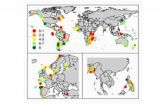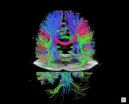(Press-News.org) CHAMPAIGN, Ill. — In one University of Illinois lab, invisibility is a matter of now you hear it, now you don't.
Led by mechanical science and engineering professor Nicholas Fang, Illinois researchers have demonstrated an acoustic cloak, a technology that renders underwater objects invisible to sonar and other ultrasound waves.
"We are not talking about science fiction. We are talking about controlling sound waves by bending and twisting them in a designer space," said Fang, who also is affiliated with the Beckman Institute for Advanced Science and Technology. "This is certainly not some trick Harry Potter is playing with."
While materials that can wrap sound around an object rather than reflecting or absorbing it have been theoretically possible for a few years, realization of the concept has been a challenge. In a paper accepted for publication in the journal Physical Review Letters, Fang's team describe their working prototype, capable of hiding an object from a broad range of sound waves.
The cloak is made of metamaterial, a class of artificial materials that have enhanced properties as a result of their carefully engineered structure. Fang's team designed a two-dimensional cylindrical cloak made of 16 concentric rings of acoustic circuits structured to guide sound waves. Each ring has a different index of refraction, meaning that sound waves vary their speed from the outer rings to the inner ones.
"Basically what you are looking at is an array of cavities that are connected by channels. The sound is going to propagate inside those channels, and the cavities are designed to slow the waves down," Fang said. "As you go further inside the rings, sound waves gain faster and faster speed."
Since speeding up requires energy, the sound waves instead propagate around the cloak's outer rings, guided by the channels in the circuits. The specially structured acoustic circuits actually bend the sound waves to wrap them around the outer layers of the cloak.
The researchers tested their cloak's ability to hide a steel cylinder. They submerged the cylinder in a tank with an ultrasound source on one side and a sensor array on the other, then placed the cylinder inside the cloak and watched it disappear from their sonar.
Curious to see if the hidden object's structure played a role in the cloaking phenomenon, the researchers conducted trials with other objects of various shapes and densities.
"The structure of what you're trying to hide doesn't matter," Fang said. "The effect is similar. After we placed the cloaked structure around the object we wanted to hide, the scattering or shadow effect was greatly reduced."
An advantage of the acoustic cloak is its ability to cover a broad range of sound wavelengths. The cloak offers acoustic invisibility to ultrasound waves from 40 to 80 KHz, although with modification could theoretically be tuned to cover tens of megahertz.
"This is not just a single wavelength effect. You don't have an invisible cloak that's showing up just by switching the frequencies slightly," Fang said. "The geometry is not theoretically scaled with wavelengths. The nice thing about the circuit element approach is that you can scale the channels down while maintaining the same wave propagation technology."
Next, the researchers plan to explore how the cloaking technology could influence applications from military stealth to soundproofing to health care. For example, ultrasound and other acoustic imaging techniques are common in medical practice, but many things in the body can cause interference and mar the image. A metamaterial bandage or shield could effectively hide a troublesome area so the scanner could focus on the region of interest.
The cloaking technology also may affect nonlinear acoustic phenomena. One problem plaguing fast-moving underwater objects is cavitation, or the formation and implosion of bubbles. Fang and his group believe that they could harness their cloak's abilities to balance energy in cavitation-causing areas, such as the vortex around a propeller.
INFORMATION:
Editor's note: To contact Nicholas Fang, call 217-265-8262; e-mail nicfang@illinois.edu.
The paper, "Broadband Acoustic Cloak for Ultrasound Waves," is available online at http://arxiv.org/pdf/1009.3310.
Newly developed cloak hides underwater objects from sonar
2011-01-06
ELSE PRESS RELEASES FROM THIS DATE:
Globally sustainable fisheries possible with co-management
2011-01-06
The bulk of the world's fisheries--including the kind of small-scale, often non-industrialized fisheries that millions of people depend on for food--could be sustained using community-based co-management. This is the conclusion of a study reported in this week's issue of the journal Nature.
"The majority of the world's fisheries are not--and never will be--managed by strong centralized governments with top-down rules and the means to enforce them," says Nicolas Gutiérrez, a University of Washington fisheries scientist and lead author of the Nature paper.
"Our findings ...
Violence against mothers linked to 1.8 million female infant and child deaths in India
2011-01-06
Boston, MA -- The deaths of 1.8 million female infants and children in India over the past 20 years are related to domestic violence against their mothers, according to a new study led by researchers at the Harvard School of Public Health (HSPH). In their examination of over 158,000 births occurring between 1985 and 2005, the researchers found that husbands' violence against wives increased the risk of death among female children, but not male children, in both the first year and the first five years of life.
"Being born a girl into a family in India in which your mother ...
Mayo Clinic determines lifetime risk of adult rheumatoid arthritis
2011-01-06
ROCHESTER, Minn. -- Mayo Clinic researchers have determined the lifetime risk of developing rheumatoid arthritis and six other autoimmune rheumatic diseases for both men and women. The findings appear online in Arthritis and Rheumatism.
VIDEO ALERT: Additional audio and video resources, including excerpts from an interview with Cynthia Crowson describing the research, are available on the Mayo Clinic News Blog(http://newsblog.mayoclinic.org/2011/01/05/whats-your-risk-of-developing-rheumatoid-arthritis/)
"We estimated the lifetime risk for rheumatic disease for both ...
Consumers prefer products with few, and mostly matching, colors
2011-01-06
COLUMBUS, Ohio – Most people like to play it safe when combining colors for an article of clothing or outfit, a new study suggests.
When consumers were asked to choose colors for seven different parts of an athletic shoe, they tended to pick identical or similar colors for nearly every element.
They usually avoided contrasting or even moderately different color combinations.
A red and yellow athletic shoe? Not going to happen. Blue and grey? That's more like it.
This is one of the first studies to show how consumers would choose to combine colors in a realistic ...
Major advance in MRI allows much faster brain scans
2011-01-06
An international team of physicists and neuroscientists has reported a breakthrough in magnetic resonance imaging that allows brain scans more than seven times faster than currently possible.
In a paper that appeared Dec. 20 in the journal PLoS ONE, a University of California, Berkeley, physicist and colleagues from the University of Minnesota and Oxford University in the United Kingdom describe two improvements that allow full three-dimensional brain scans in less than half a second, instead of the typical 2 to 3 seconds.
"When we made the first images, it was unbelievable ...
UConn cardiologists uncover new heart attack warning sign
2011-01-06
Cardiologists at the University of Connecticut Health Center have identified a protein fragment that when detected in the blood can be a predictor of heart attack.
Their research, led by Dr. Bruce Liang, director of the Pat and Jim Calhoun Cardiology Center, is published in the Jan. 11 issue of the Journal of the American College of Cardiology. It found heart attack patients had elevated levels of the protein fragment known as Caspase-3 p17 in their blood.
"We've discovered a new biomarker for heart attack, and showed that apoptosis, or a particular kind of cell death, ...
Scientists now know why some cancers become malignant and others don't
2011-01-06
Cancer cells reproduce by dividing in two, but a molecule known as PML limits how many times this can happen, according to researchers lead by Dr. Gerardo Ferbeyre of the University of Montreal's Department of Biochemistry. The team proved that malignant cancers have problems with this molecule, meaning that in its absence they can continue to grow and eventually spread to other organs. Importantly, the presence of PML molecules can easily be detected, and could serve to diagnose whether a tumor is malignant or not.
"We discovered that benign cancer cells produce the ...
School-based interventions for obesity
2011-01-06
St. Louis, MO, January 6, 2011 – Thanks to the Let's Move initiative, society is becoming more aware of alarming statistics like 1 in 4 children are obese and childhood obesity has nearly doubled over the past two decades! With this platform, nutrition education and physical activity in the classroom have taken the forefront against this growing epidemic. A study in the January/February 2011 issue of the Journal of Nutrition Education and Behavior explores twenty-six school-based nutrition interventions in the United States.
Investigators performed a content analysis ...
InfoCom says satellite and cable dominate the market for paid-for TV subscriptions.
2011-01-06
News Body (Max 2800 characters)
Stuttgart, Germany — According to InfoCom most recent release of the Quarterly TV Monitoring, the top-10 largest groups, at World level, collectively posted 145m paid-for* TV subscriptions, 54% of which attributed to satellite TV (2Q10). The top-10 ranking is lead by US-based satellite TV player, DirecTV, with 25m subscriptions, of which 25% from its Latin American subsidiaries (Argentina, Brazil, Chile, Colombia, Mexico, Puerto Rico and Venezuela). DISH Network, another US-based satellite TV player, is ranked 4th, with 14.3m subscriptions, ...
UAE Exchange moves to new spacious premises in Musaffah Sector 10 Abu Dhabi
2011-01-06
UAE Exchange, the leading global remittance and foreign exchange brand, today opened its new spacious and more convenient premises in Musaffah Sector 10, in a move to enhance the service and value proposition of the brand to its loyal customers in and around Mussaffah. The branch was inaugurated by H. E. Abdulla Humaid Ali Al Mazroei, Chairman, and Dr. B. R. Shetty, MD & CEO, UAE Exchange in the presence of Mr. Sudhir Kumar Shetty, COO - Global Operations, other senior officials of UAE Exchange, special invitees and the Press fraternity.
The new branch is located in ...



